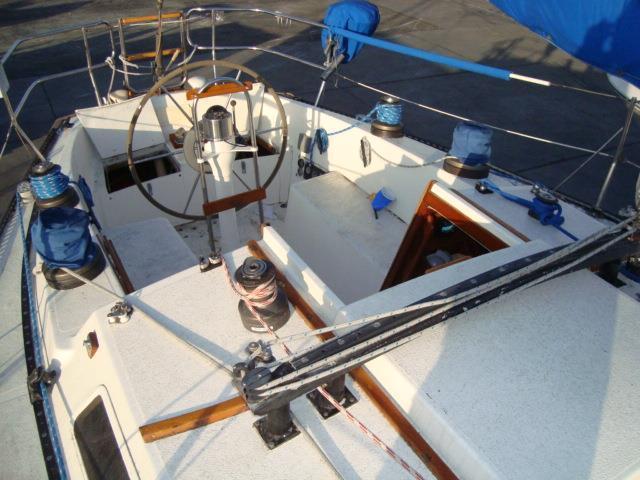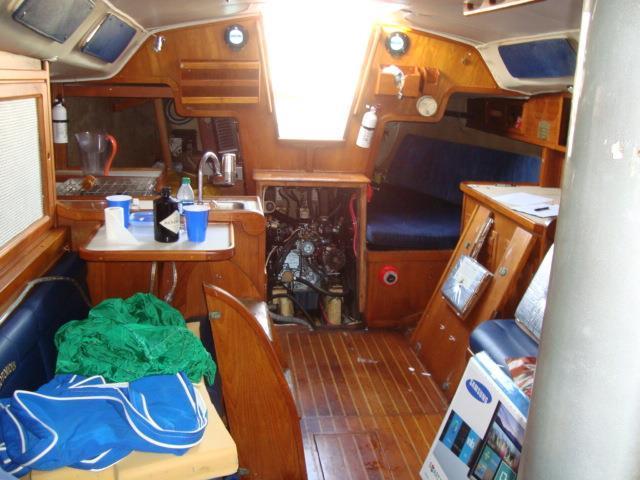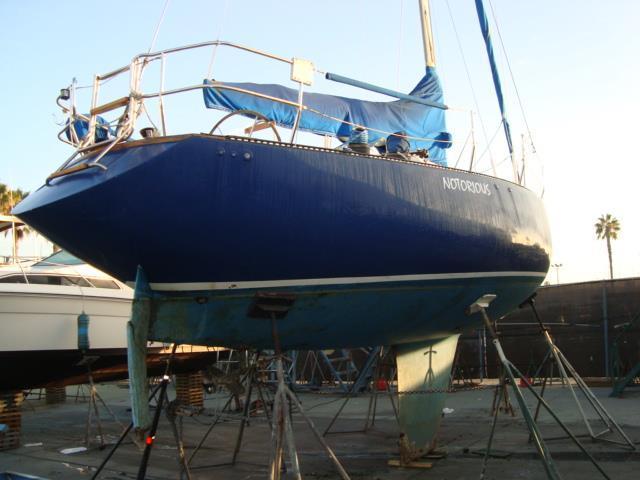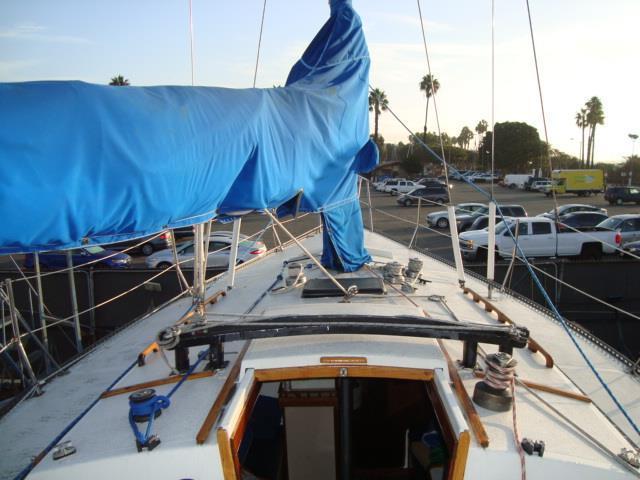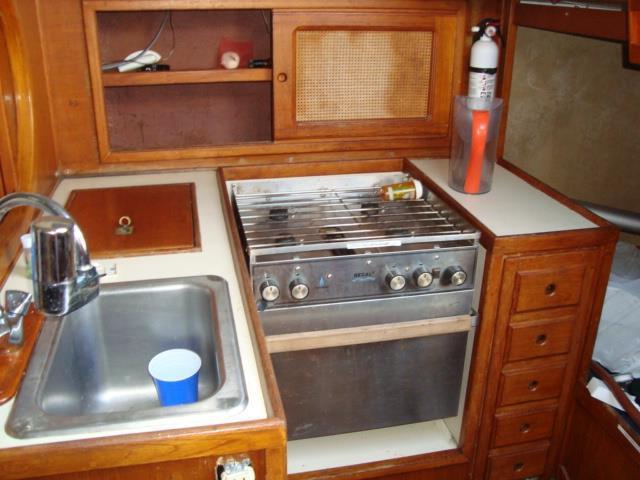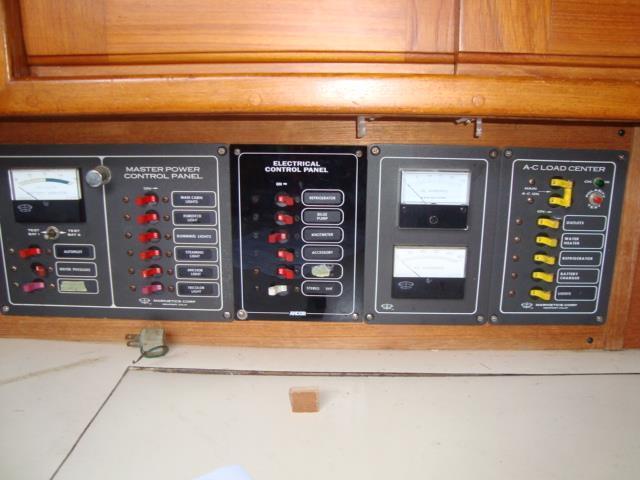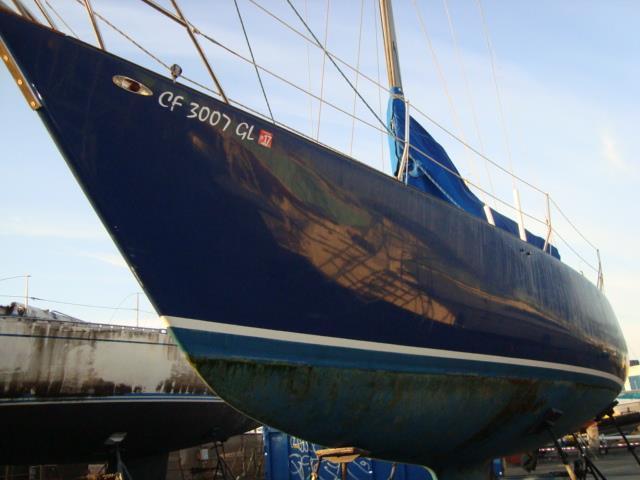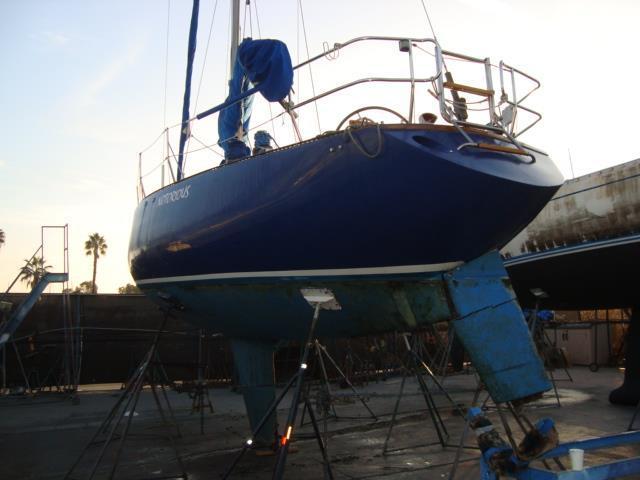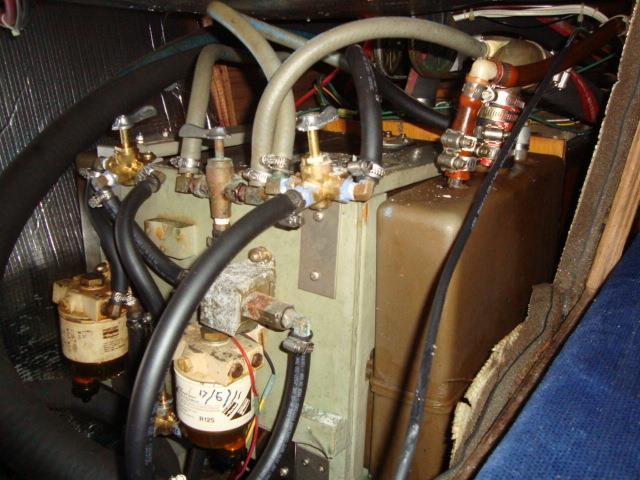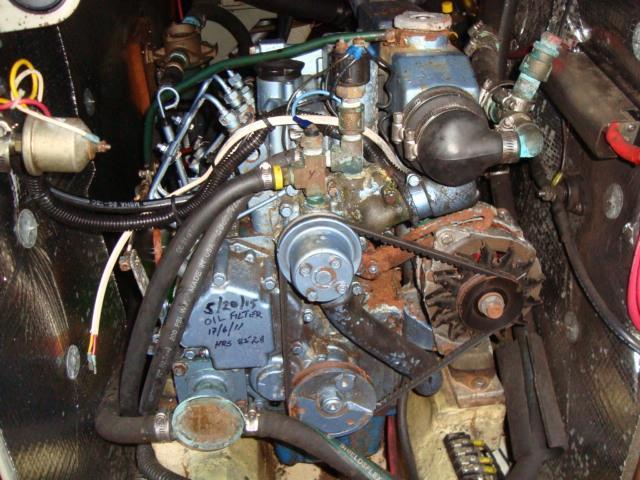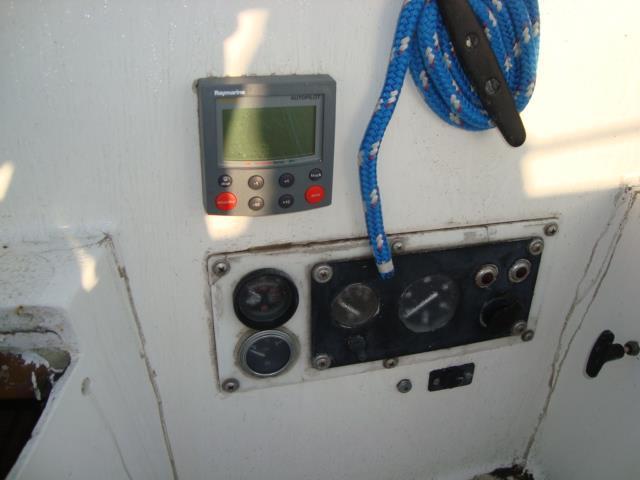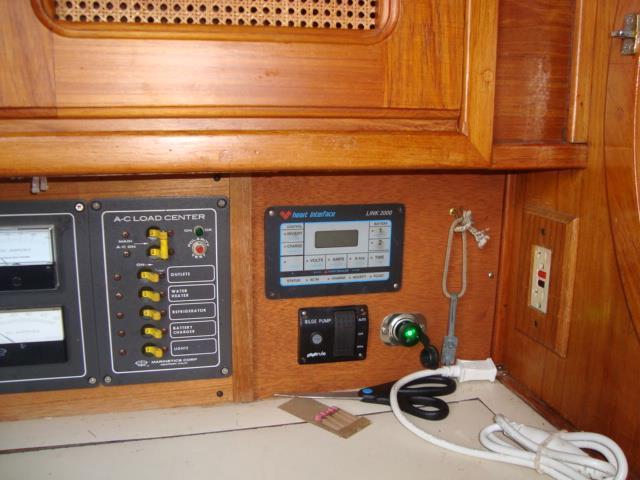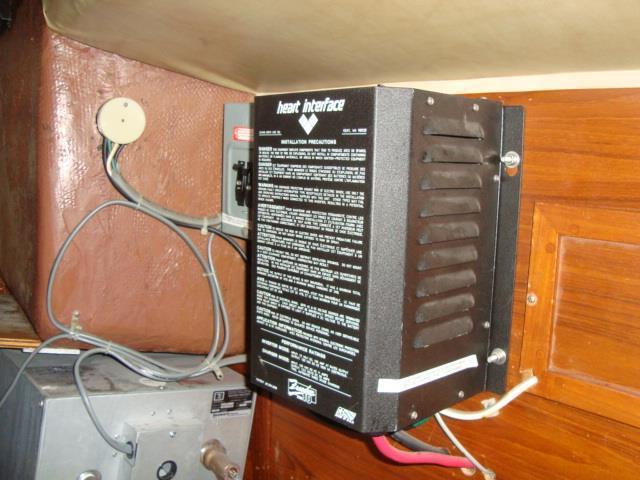No Reserve FAST CAPABLE PACIFIC OCEAN CRUISER- SPACIOUS INTERIOR -Wheel Steering
1978 CF 37 Blue Water Racer Cruiser for Offshore and Coastal
- Price: Contact seller
- Make: CF 37
- Model: Blue Water Racer Cruiser for Offshore and Coastal
- Type: Cruiser
- Year: 1978
- Location: Venice, California, United States
Description
The Dencho Marine CF 37 is well regarded as one of the most solidly built fast-sailing Ocean Cruisers ever built. They have a very comfortable and spacious interior and terrific deck layout. They perform very similar to the much better known Beneteau and Jeanneau Racer Cruisers in the 36 to 38 foot class. However, due to the luxury taxes imposed in the 1980s, the company, like hundreds of other non-corporate sailboat makers, was not large enough to survive the down-turn in sales and went out of business along with dozens of other yacht makers.Dencho Marine vessels however, have stood the test of time as one of the higher quality builders of the "Classic Plastic" era. Among serious ocean sailors they are legendary vessels, despite the fact that only ten of them were built. In the 1980s and 90s, in order to survive economically, the larger companies, Hunter, Catalina and Beneteau, all shifted to the cheaper method of blown-chipped fiberglass using resin to glass ratios that were much higher than was used to build these very strong hand laid vessels which were built with molded lead keels rather than the cheaper bolt-on cast-iron keels. The lead in the keel alone on this vessel is worth $12,000 (6000 lb at the current lead spot price of $2 lb). Is is any wonder why the cheaper mainstream brands went to building with the much cheaper bolt-on cast-iron option when in modern dollars that decision would remove $12K up front from the manufacturing price.
PRIOR TO BIDDING PLEASE READ THE ENTIRE AUCTION TEXT TO BECOME A FULLY INFORMED BUYER. FEEL FREE TO CALL ME IN PERSON TO DISCUSS THE BOAT AND YOUR CRUISING PLANS WITH IT. William 970 319-4361
PAYMENT IS DUE IN FULL WITHIN 24 HOURS - NO EXCEPTIONS. PLEASE RESPECT THAT WE ARE ONLY SELLING THE BOAT BECAUSE WE NEED THE MONEY ASAP TO PAY OTHER BILLS.
This auction closes a little after 9:30 pm Eastern time on Saturday night. If you want to win the auction make sure to get your best bid in early or else set the alarm on your phone and log on to monitor your bidding status in the final few minutes of the auction. Sometimes the final few minutes can determine who wins the auction.
I hope it goes to a good home.
37 feet is the perfect size for a couple or a small family to circle the globe. You have enough room inside for comfortable accommodations and plenty of stowage for gear and provisions keeping clear paths for movement about the boat and a pleasant and luxurious interior feel. However, it also small enough that a crew of two (or even one person with an autopilot) can handle the boat easily on long passages without the need for additional crew people or complicated and error prone mechanical systems such as in mast furling and electric winches which are inevitably prone to failure when you need them the most.
The incredible ballast to displacement ratio of 44.45% of the CF 37 puts it in a class of performance, stability and comfort of the newer yachts costing upwards of $300K, especially when all that weight downstairs is true lead rather than the bulkier cast-iron. Still, the sail area to displacement ratio of 17.84 gives this boat incredible performance sailing characteristics that make it possible in most cases to out-run huge Pacific Ocean storms rather than getting stuck in the middle of them. These numbers also make for more nautical miles per day on long passages and the ability to sail closer to the wind than many other lesser species of production ocean yachts enables it to conserve diesel fuel and continue on sail power alone at angles where many lesser yachts are forced to fire up the internal combustion engine to get where they want to go ahead of the shifting weather systems.
Long strand woven roving fiberglass cloth bonded by minimal amounts of polyester resin scraped in between multiple layers is the fiberglass building technique that truly has the strength to survive serious off-shore ocean storms and like this boat, can take a grounding and survive with only a few minor scuffs and a busted rudder. The newer (and cheaper) methods of building yachts use far too much resin and not enough fiberglass, because by weight, polyester resin is about five times cheaper than fiberglass cloth. Using drywall style blown chip guns rather than hand laid rolls of woven roving glass also saves tons of labor cost for the boat manufacturer because hulls can be laid up in a single day rather than taking weeks or months to complete. However, the trade-offs in the cheaper methods of construction are that the boats are no longer truly sea-worthy for the open ocean and the sort of conditions that can be thrown upon the sailor and his or her craft thousands of miles from the nearest safe harbor. This is one of the major differences that separate a weekend cruising vessel for near-shore sailing from a true Blue Water vessel built for long ocean passages with the inherent dangers of the possibility of major storms and incidents far from VHF hailing distance of rescue vessels.
Not every sailor needs such a durable vessel as this one. It is entirely possible to spend an entire life-time sailing on fair weather days only hours beyond your port of call or on safe and protected inland lakes or coastal bays. However, for sailors planning to venture into the far seas and cross huge expanses of thousands of miles of open ocean, spending twice or three times the money to purchase a true Blue Water vessel is not a matter of pride or ego but of life-saving necessity.
The CF 37s are well known among elite sailors as some of the toughest high performance sailing machines ever built. The problem is that they are very hard to find on a budget for middle class cruisers who can't afford to spend several years salary on the purchase of a vessel.
In 15 years of cruising and serious ocean sailing this boat is the first time I have located one of these desirable vessels that was priced below $25K. When I found out about it I knew I had to buy it and try to find some sailors worthy of bringing this fine small ship back to life and hopefully enabling them to pursue the goal of full-time ocean cruising for a fraction of the price they would have to pay for such a boat at fair-market value.
Whoever gets the rare privilege of owning this fine vessel and returning it to its former glory will truly be the recipient of a once in a life-time opportunity. With only 9 other CF 37s in the world, you will likely never have another opportunity to own one without having to pay full retail for it.
A little about us:
My wife and I are serious blue water ocean sailors with thousands of miles and many years experience offshore and doing coastal cruising. It is our passion to help other people discover the sailing lifestyle, and especially the more serious cruising lifestyle.
We already have our keeper boat and don't need another one, but every once in a while we discover through our friends and connections at boatyards, marinas and marine insurance companies a boat that is a terrific bargain that isn't getting the love and attention and exercise that it deserves, and we will try to help find a new home for it. This is one of those rare boats. If you want to call me and discuss your cruising or sailing plans and dreams and whether or not this boat might actually work to suit your needs I will be happy to speak with you and give you my honest opinion about the feasibility of your plans and whether this vessel might or might not work for you. Feel free to call and chat. William 970 319-4361
ATTENTION: THIS IS A SERIOUS LISTING FOR A SERIOUS BOAT. YOUR BID OR BEST OFFER IS A LEGALLY BINDING CONTRACT TO PURCHASE THIS SAILBOAT THE SAME AS A CONTRACT TO PURCHASE REAL ESTATE OR A NEW CAR. BY PLACING YOUR BID YOU AGREE TO THE TERMS OF THE AUCTION AND THE PAYMENT TERMS. PLEASE CONSIDER ALL OF THIS PRIOR TO CLICKING THE PURCHASE BUTTON.
PLEASE READ THE ENTIRE TEXT PRIOR TO BIDDING AND MAKE SURE YOU THAT YOU HAVE AS MUCH INFORMATION ABOUT YOUR PURCHASE AS POSSIBLE. I AM HAPPY TO ANSWER QUESTIONS ABOUT THE BOAT AND YOU ARE WELCOME TO GO AND SEE IT IN PERSON PRIOR TO BIDDING IF YOU LIKE. CALL ME WILLIAM AT 970 319-4361.
PAYMENT IS DUE IN FULL WITHIN 24 HOURS. SEE PAYMENT TERMS. CLEAR TITLE IS AVAILABLE. Notarized Bill of Sale will be issued right after payment is received. Title will take several days after that to be processed and re-issued.
MOVING A BIG SAILBOAT WITH A BOAT MOVER CAN BE VERY EXPENSIVE. OFTEN $4 OR MORE PER MILE. I AM HAPPY TO HELP YOU UNDERSTAND THE OPTIONS IN THAT REGARD IF YOU WANT TO GIVE ME A CALL. THIS BOAT COULD ALSO BE MOVED BY WATER, WITH ONLY A FEW PREPARATIONS FOR RE-LAUNCH, IF YOU ARE A DECENT SAILOR AND HAVE A COUPLE GOOD CREW PEOPLE TO GO WITH YOU.
AND NOW IF YOU AREN'T YET TIRED OF READING A FEW INSIGHTS TO SHARE ABOUT BUYING BOATS AND CHOOSING THE RIGHT BOAT FOR GLOBAL CRUISING:
Our passion is to assist folks who are making a transition from day sailing or coastal cruising to becoming full-time live-aboard world cruisers. We also assist new sailors who are just getting into the sport of sailing by advising them on how to develop their skills and how to make plans to pursue the dream of cruising and world traveling full-time.
We have extensive contacts and resources for finding good world cruising boats at far below their fair market value, and occasionally we discover an amazing neglected vessel at a price that we know may enable a cruising family or a retired couple on fixed income the ability to pursue the dream of cruising without the sort of means and savings normally associated with pursuing this lifestyle.
In those cases, like this boat, we work to try and find a new home for a good “below market value” boat, with people who will fully restore the vessel, and hopefully use it for the serious cruising that the boat was designed for.
There are many aspects of life where experience really matters, but none so much as global cruising. When you are planning to take a small boat across vast oceans and visit foreign ports of call on your own terms you must truly learn to become Master's of your Own Destiny. It doesn't matter how wealthy you are or how talented you are at managing large organizations or companies with dozens of staff people.
When you are on a boat in the middle of the ocean, the choices you have made, the choices you will make and your own internal skills and the undeniable truth of how well or poorly you have planned for your expedition, are the factors that will determine whether your experiences become a positive adventure or a frightening (or even life threatening) catastrophe.
When you are looking at a boat parked peacefully at a dock or on jack stands at a boat yard, you will be tempted to judge it based on whether the lines are nice and whether it is pretty or ugly and whether it is new or old and well kept or run down.
The ocean however, operates according to immutable laws of physics. The ocean does not care whether it sinks a pretty boat or keeps an ugly one floating. It does not care whether you are a skilled sailor with dozens or years experience under your shade hat or whether you are an amateur on your first weekend pleasure cruise. You will be served exactly the same conditions of wind and waves whether you were born wealthy or if you were raised in a cave by wolves.
The only control you have over these situations is knowing when to sail and when not to sail, and you can prepare yourself so that when the wrong situation strikes, if it ever does, you are skilled and prepared to deal with it and have a vessel that is prepared to handle the same.
For people who are wanting to go cruising full-time, or who want to go from being pleasure sailors to competent seamen and sea-women, choosing the right boat is the first and sometimes ultimately most important decision of their nautical lives.
Of course you can always sell or trade a boat and then buy a different one, but still the choice of each boat will influence the experiences you have and it will determine in many ways the capabilities or limitations of what you can or can't do while you have that boat for your home—even if it is only home for a few weekends here and there.
There are many nuances and subtleties to sailing, as well as to each individual vessel. A boat that may be just exactly perfect for one sailor or family of sailors, may be completely the wrong boat to suit another person's dreams.
By nature, boats require a lot of maintenance and upgrades, and if you are someone who wants all the possible bells and whistles, boating can be a very expensive occupation.
However, there are also ways to save a lot of money and still pursue the dream effectively and safely and create a new floating paradise for yourself. But each person or each couple's needs are different.
There is no such boat as a boat that is not a project boat.
Long before we were married, when my wife was only 12 years old, and her father (a relatively wealthy man at the time) purchased a brand new Beneteau 46 for the family to live on for years and to cruise the world on, the first thing he did to a brand new half million dollar boat was to spend another $27K on equipment upgrades, new electronics installations and custom modifications.
The reason he did that is because no boat, no matter how shiny and brand new, is exactly right for everyone's individual tastes and needs, and no boat comes straight from the factory completely ready to do anything other than Wednesday afternoon beer can races.
I often get asked by people who are shopping for a used boat to go cruising the world, “Is this boat ready to cross the Atlantic?” or “Does it need anything before it is 'Ready to Sail.”
The very nature of that question is a showcase of their naivety. Even if the answer were “Yes, the boat is ready.” (which would be impossible to have any boat ready unless you have spent thousands of dollars on a cruising chandlery and provisioning service ahead of time) the greater question is “Are such ignorant sailors who need to ask such questions ready themselves?”
Even if they had the absolutely perfect boat, prepared ahead of time by die-hard professionals to get it ready to cast off the lines and sail to points distant and exotic, would the sailors know where everything is at on the boat and how to operate those systems and how not to break them with ignorant mistakes or how to fix them once broken? And if they knew all those things, would the boat be equipped with the necessary repair tools and supplies as part of the process of getting it ready to sail?
So all these are big questions, and the only easy answer is that any sailor must become intimately familiar with their vessel prior to making long voyages beyond sight of land. The easiest way to become familiar with a boat so that it is not a stranger but rather a trusted old friend is to do a lot of weekend coastal cruising with it, while you work all the bugs out. Also, the more projects and upgrades you do yourself the more familiar you will be with how they work, how to maintain them and how to fix them again if anything every goes wrong. To depend on the expertise of professionals left behind in a port in a distant country you cleared out of months ago is only to invite future disaster...and its also much harder on the wallet.
So any time you can add to your own skills and knowledge of your own boat by doing your own work, or hiring a professional to help you do it yourself, you are preparing yourself for future success as a cruiser.
Any boat, even a brand new boat, will have things about it that you want to change or upgrade or move or install prior to making long voyages.
The better questions to ask are:
“What is the proper amount of maintenance and upgrades that I will make to my vessel prior to setting sail?
How many things need to be changed or fixed before I leave the continental US?
How many projects will I work on, as little projects along the way, when I have a slow day at a boring anchorage and there are no cruiser parties to attend and no interesting conversations of the side channels of the VHF.
How many projects are absolutely vital to get accomplished before I begin actively using the boat as a full time residence and a floating RV that can sail to any country with a coastline?”
How many projects do I want to tackle myself if it means I can save literally tens of thousands of dollars on the purchase price of a boat, and how much more ultimate value do I get for my money by buying a larger or more seaworthy boat with a few bigger projects to tackle than if I buy a smaller or more flimsy boat that is cleaned up nicer and has fewer problems to address. (Remember the ultimate cosmic law of boating – even if you can't see any problems at all with a boat, and no projects needing doing, as soon as you own it and begin to sail it, you will start to find those quirks and bugs) So don't fool yourself into believing that you can simply buy a shiny new boat from a broker at full market value, or even by paying more than boat blue book value, to avoid ever having to make repairs or upgrades.
Any experienced sailor or boating professional other than someone selling fancy new boats will admit to you that there is no such boat other than a “project boat.” The only question is “What are the projects and how much money will I save by doing them myself versus hiring someone else to complete them?”
Every boat that I have ever bought or ever sold, which is now many dozens of them, had varying degrees of things needing to be improved about it. Even the brand new boats straight from the showroom floor or boat show sales dock will need bottom painting and new zincs and fuel cleansing treatments and oil changes and manifold and riser inspections within a matter or months of casual weekend use.
The longer any boat sits without the proper level of loving regular maintenance the faster it will deteriorate, and tiny 15 minute projects will turn into hour-long projects and hour-long projects will turn into day-long or week-long projects due to continuing neglect.
The quality of the build is also important. A cheap boat will have cheap boat problems, and it will have serious issues far faster and more frequently than a very well built boat from an esteemed yacht designer and builder even if the better boat looks worse initially.
In many ways you are better off to buy an older and more well regarded vessel in worse “first impressions” condition than to buy a shiny and well kept cheaper new boat. In the long run the better boat will cause far fewer headaches once you have it restored fully and you are taking care of it yourself, whereas the cheap but glossy boat may still look new and shiny for years, but begin having serious and costly problems that cannot be seen even while it still looks great in Facebook boat pictures.
Boating is like riding a horse or driving a high performance sports car. You always have to be involved in the life of your boat whether you use it frequently or not.
But this is not a bad thing, because it is part of the pride of ownership, and the regular maintenance and upkeep and small projects is what enables you to avoid the big ones or to at least know which big ones you need to do sooner and which ones can wait till later.
--
As you will guess by now, I'm a bit of a philosopher sailor when it comes to helping folks find just the right boat to serve their needs.
I am currently writing a book on that very topic which will be called, “The Seven Questions of Cruising (or) the Seven Questions you should ask yourself before buying a Boat.” Here is a quick preview of the questions you should be trying to answer from the introduction to my new book.
--
When you go to buy a boat, especially if it is your first boat, there are a lot of decisions to be made and hard choices to figure out.
Before you begin searching for the correct vessel to serve your needs, you need to first ask yourself, (and your cruising partners/ spouse etc) some important questions which will help you immensely in the quest to find the perfect small ship to suit your needs.
Question # 1- Where do you want to sail to (now and also possibly in the future)?
#2 – Who might be going with you and/or who might want to visit you and stay on the boat with you once you get to that exotic foreign port (if global cruising is your goal) or that incredible weekend getaway spot (if weekend cruising is your thing).
#3 – How much do you want to spend on this adventure called boating/sailing/?
Also, how much “can” you afford to spend if you happen to take a wrong turn with the adventure and “need” to spend more money to fix a problem or get yourself or your stalwart side-kick (your boat) out of trouble?
#4 – How handy are you? (i.e. - Are you someone who naturally takes pride in your ability to figure it out yourself, or are you the person who would rather call an “expert” and pay them to solve whatever problem you are having?
#5 – How much time do you have to save yourself money, because in sailing, as well as in life in general “time often equals money.”
#6 – Are you a weekend warrior and/or charter sailor, or do you want to cruise full time?
#7 – Do you care more about Getting There or more about “Being There” once you have arrived?
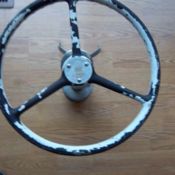 VINTAGE CENTURY BOAT DELUXE WHIT-KUM STEERING WHEEL
VINTAGE CENTURY BOAT DELUXE WHIT-KUM STEERING WHEEL
Model: 1950
Year: 1950
Location: Tomahawk, Wisconsin, United States
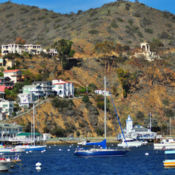 HUGE INTERIOR- GORGEOUS WORLD CRUISER in Mystical Island Paradise NO RESERVE
HUGE INTERIOR- GORGEOUS WORLD CRUISER in Mystical Island Paradise NO RESERVE
Model: 1978
Year: 1978
Location: Avalon, California, United States
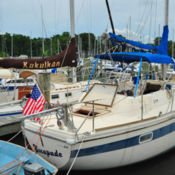 NO RESERVE - Famous Designer - HUGE INTERIOR Shoal Draft -Island Charter Cruiser
NO RESERVE - Famous Designer - HUGE INTERIOR Shoal Draft -Island Charter Cruiser
Model: 1976
Year: 1976
Location: Annapolis, Maryland, United States
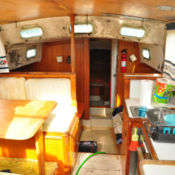 PERFECT VESSEL FOR COUPLE TO CIRCUMNATIGATE -GLOBALLY CAPABLE PILOTHOUSE CRUISER
PERFECT VESSEL FOR COUPLE TO CIRCUMNATIGATE -GLOBALLY CAPABLE PILOTHOUSE CRUISER
Model: 1969
Year: 1969
Location: Solomons, Maryland, United States
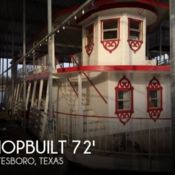 1982 Shopbuilt 72 Paddle Wheel Cruiser Used
1982 Shopbuilt 72 Paddle Wheel Cruiser Used
Model: 1982
Year: 1982
Location: Whitesboro, Texas, United States
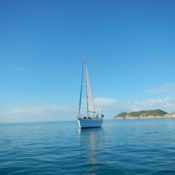 Spacious 35' Center Cockpit Liveaboard Sailboat (Loaded!) NO RESERVE
Spacious 35' Center Cockpit Liveaboard Sailboat (Loaded!) NO RESERVE
Model: 1974
Year: 1974
Location: Albuquerque, New Mexico, United States
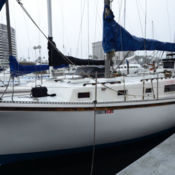 NO RSRV-SPACIOUS GLOBAL CRUISER- $8K Diesel Engine Runs Exlnt. PERFECT 4 ISLANDS
NO RSRV-SPACIOUS GLOBAL CRUISER- $8K Diesel Engine Runs Exlnt. PERFECT 4 ISLANDS
Model: 1974
Year: 1974
Location: Marina del Rey, California, United States
 2016 Hewescraft 220 Pacific Cruiser ET Used
2016 Hewescraft 220 Pacific Cruiser ET Used
Model: 2016
Year: 2016
Location: Sterling, Alaska, United States
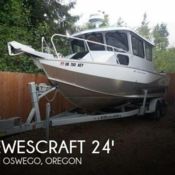 2014 Hewescraft 240 Pacific Cruiser Used
2014 Hewescraft 240 Pacific Cruiser Used
Model: 2014
Year: 2014
Location: Lake Oswego, Oregon, United States
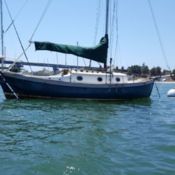 Pacific Seacraft 25, no reserve
Pacific Seacraft 25, no reserve
Year: 1978
Location: Coronado, California, United States
